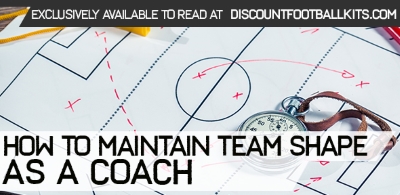If you watch any Premier League game in the modern age (especially those involving sides such as Manchester City and Chelsea), you’ll see an increased focus on team shape both in and out of possession.
This not only enables players to remain compact and press the ball aggressively to present transitions, but it also lays the foundation for ball retention and enjoying structured possession in games.
Of course, creating and maintaining team shape can be more problematic at youth or grassroots level, and there are several reasons for this. But how can you go about maintaining shape as a grassroots team coach?
Addressing the Issue
When coaching on a part-time basis or in amateur competitions, you’ll find players enrolling at different levels of fitness, experience and ability.
This makes it fundamentally hard to organise players and successfully coach the principles of team shape, as not all individuals will have the discipline to maintain their position or the physical fitness to track opponents and utilise space.
Think about it; this is why youth games (particularly including players aged seven or under) often feature a scrambled selection of players, who shift in unison to create overcrowded zones and ample space across the pitch.
The issue is often exacerbated by the part-time and sporadic nature of grassroots coaching, which minimises the time in which managers can impart the basics and mechanics of team shape.
Make no mistake; you only need one or two players to undermine your team’s shape, so the challenge facing coaches in this respect is absolutely evident.
The Coaching Drill and Setup
Fortunately, there’s a simple drill to help impart team shape, which should ideally be set up with 10 players and your goalkeeper within one half of a full-sized pitch.
Alternatively, you can play with 22 players on a full-size pitch, but it may be better to adopt the former approach when starting out.
You’ll also need eight cones and three small goals, the latter of which are positioned in the middle line (with one on each wing and another right in the centre of the field).
Your players should be separated into defence and attack, and when playing with 11 you can alternate between having an extra attacker and defender.
How to Operate the Drill
You’re now ready to start the drill, so we’ve broken it down into a little more detail below. So, let’s begin!
The object of the drill is to ensure that both attacking and defending players maintain their shape during the action, placing a focus on retaining possession and pressing the ball.
During gameplay, only three touches of the ball are allowed, including one to control, another to change direction and a third to execute a pass
No more than two players are allowed in any zones distinguished by the cones; namely one defender and one attacker
Attacking players can only pass the ball to a teammate in a contiguous zone, allowing for the development of quick and structured possession
Similarly, defenders can only clear the ball beyond a contiguous zone if the ball is in the penalty area, encouraging players to play out safely from the back
When the defensive team recovers the ball, their objective is to transition and subsequently score in the small goal
The Last Word
Of course, you can vary the rules as you wish, while remembering that the core objective is always to maintain team shape when carrying basic tasks such as ball retention and pressing.
Over time, this drill can really help players to get to grips with team shape, both when they’re in possession and looking to retain the ball and during the defensive phase of the game when the aim is to restrict the space for opposition players.
Make no mistake; a disciplined team shape can benefit every aspect of your game, and the sooner you drill this into your players, the better!










